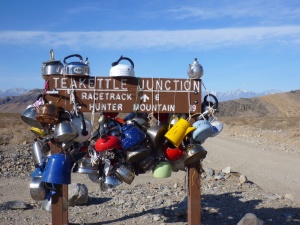Enemy #1 is actually two distinct species of a small, annual grass with Euro-Asian ancestry that have taken over many arid lands in the west. In desert ecosystems characterized by well spaced shrubs and perennials, these invasive grasses can spread into a carpet. This new source of fuel that can carry a wildfire across a landscape where fire is historically rare and enormous fires unheard of. Starting in 2005, enormous wildfires burnt through southern Nevada, fueled in a large part, by these invaders. Allow me to introduce these Bromus Brothers:
Monthly Archives: February 2012
How to build a map
Once upon a time, I used to make my living making maps. Not making maps, really, using existing maps to collect data to build better maps. We collected data on the plant communities across national parks, to build vegetation maps that can be used to protect endangered plants, preserve critical habitat for animals, study the effects of climate change, and basically provide a baseline for any kind of ecological research that might be done in the park. I’ve worked on these projects at Denali, Lake Mead, Death Valley, and Mojave National Preserve. The process, at all of them, is pretty similar, although the temperature, scenery, and flora certainly varied. Here’s the story of how my crew mapped the plants across Death Valley National Park.
Welcome to the No-Yawn Zone!

Dunkleosteus Jaw, by Travis S. via Flickr
My jaw hurts. Moving my right jaw joint has been painful since Saturday. But, I’m not trying to write a blog post to whine about my life. I swear. Instead, as I began to research why my jaw could suddenly start hating me for no particular reason, I stumbled upon a complex, confusing medical diagnosis that effects quite a few American women: TMJ disorders.
TMJ stands for Temporomandibular Joint. This is the joint that functions as the hinge where your lower jaw (the mandible) connects to the temporal bone, the portion of the skull in front of your ears. The joint’s inherent flexibility allows you to chew, chat, and most importantly, yawn, pain free, when life gets really boring or your caffeine levels drop.
Data Vis Diary: Words, words, words
I discovered Google’s ngrams last week through my data vis class. Basically, the Google Books project digitized millions of books and scanned all of the words, amassing a giant database of billions of the words published in the past 200 years. What’s really cool is that Google has built an online viewing tool that you can use to graph the frequency of any word that you are interested in, over any time period in the last 200 years. The results look like this:
On Winter: Who’s Afraid of the Dark?
As soon as I decided to move from Las Vegas to Wisconsin, people starting warning me about winter. I bought coats, boots, and long pants. But, ironically, Wisconsin is having a really mild winter….I have only worn the snow boots a couple times.
However, winter in Wisconsin has not been easy for me. It’s not the cold, or the snow that I’m afraid of, it’s the darkness. The short winter days, the overcasts skies (not today, yay!),and cold enough weather that you don’t want to loiter about outside with your skin exposed all contribute to a lot less sunlight exposure. When I started settling in to graduate student life (aka lots of time sitting in front of a computer) and the fall daylight started slipping away, I started to feel low in energy. I’m a morning person, and it was hard to wake up, hard to function on full power, hard to convince myself to get challenging things done. I diagnosed myself with sunlight deficit disorder.
Data Visualization Diary: Magazine Sales
(First post in my Data Visualization Diary series, where I explore a data set, try to find the interesting stories that the data contains, and practice techniques for using images to communicate the stories that the data has to tell. Through these experiments, I hope to learn what visuals work well, and which fail to communicate in an interesting, efficient, and understandable way. Comments and suggestions welcome)
Today, I picked a data set that journalists everywhere might find interesting. The 6 month data on magazine subscription and single issue sales were released by the Audit Bureau of Circulations. Only the data for the top 25 magazines in each sales category, circulation and single issue, were released online. You can see the data I started with on their website, here.
So, the first thing I noticed, looking at the data, is that subscription sales are much higher than single issue sales. Also, for the most part, different magazines made the top 25 in each category. Only 7 magazines made the top 25 in both categories:





